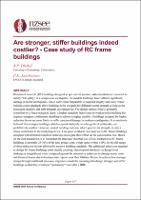Are stronger, stiffer buildings indeed costlier?: Case study of RC frame buildings
Abstract
Seismic codes/standards allow buildings to be designed for different lateral strength as long as the associated ductility and drift demands are catered for. The design seismic force is primarily controlled by a force reduction factor; a higher reduction factor leads to weaker/softer building but requires stringent confinement detailing to achieve a higher ductility. Buildings designed for higher reduction factor are more likely to suffer structural damage in moderate earthquakes. It is intuitively believed that stronger buildings, which respond elastically in a design level earthquake, are prohibitively costlier. However, cost of building skeleton, which governs its strength, is only a minor contributor to the total project cost. This paper conducts cost analysis on RC frame buildings designed with different reduction factors to investigate their effect on the construction cost. Based on the cost breakdown, it is found that the structural material cost of low-medium rise RC frame buildings is normally 25-30% of the total project cost, which varies within ±10% for the full range of force reduction factors allowed by modern building standards. The additional initial cost required to design RC frame buildings (with ductile detailing) that respond elastically in design-level shakings is insignificant when compared against the cumulative reduction in damage repair costs and financial losses due to business interruption over their lifetime. Hence, to achieve low-damage design through traditional measures, engineers should be encouraged to design stronger and stiffer buildings so that they remain in “operational” state after a DBE.

